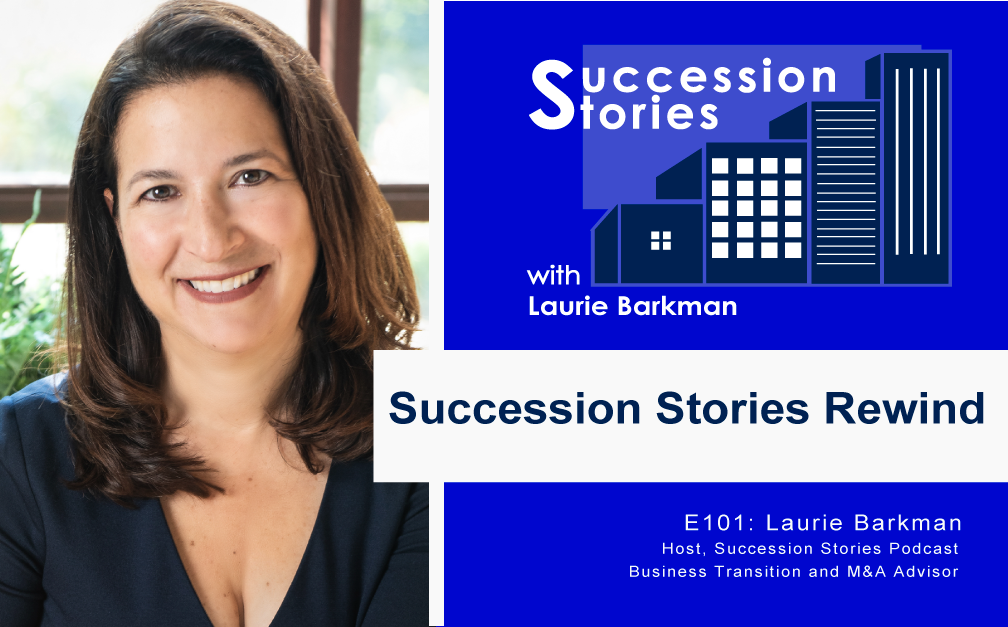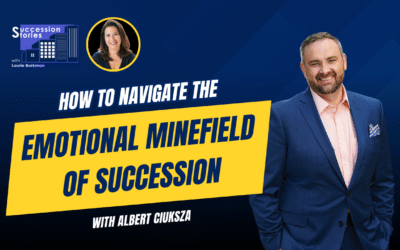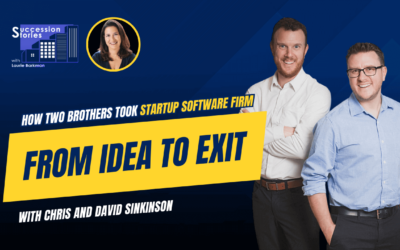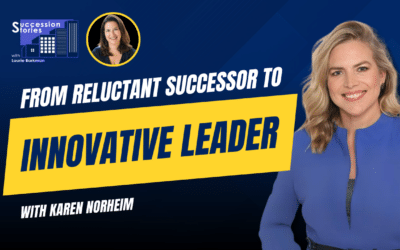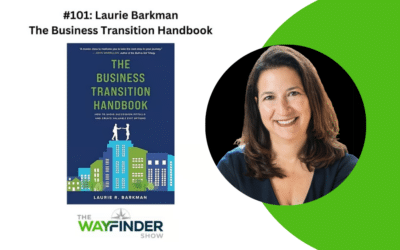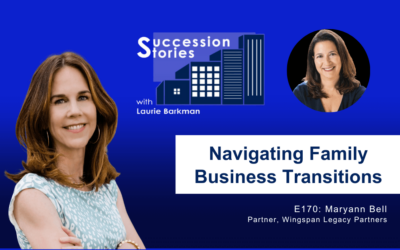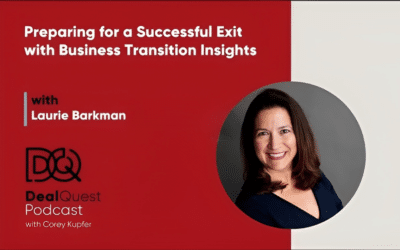We’re rewinding the first 100 episodes of the Succession Stories Podcast. Host Laurie Barkman shares favorite clips spotlighting key themes of the show– innovation, growth, and transition. Today’s Rewind topics include next generation leadership, corporate innovation, enterprise value scorecards, and succession.
This episode re-broadcasts clips from conversations with just a few in a long list of extraordinary guests.
Show Links:
- Lisa Laird Dunn and Gerard Dunn, Laird & Company (E34)
- Karen Norheim, American Crane and Equipment Corporation (E50)
- Steve Peplin, Talan Products (E69)
- Beth Miller, Executive Velocity (E74)
About Succession Stories Podcast
Succession Stories is an award-winning podcast hosted by Laurie Barkman, the Business Transition Sherpa– guiding business owners through the process from “transition to transaction.” Subscribe to Succession Stories and share a review if you enjoy the show!
Learn more at https://thebusinesstransitionsherpa.com
Book a 1:1 Advisory call at: www.meetlauriebarkman.com
_______________________________________
Become an Official Patron of Succession Stories Podcast:
https://www.patreon.com/lauriebarkman
Don’t leave your exit to chance.
Stony Hill Advisors works with owners like you to get ready and maximize value when you’re ready to sell.
Visit www.stonyhilladvisors.com/podcast for a complimentary business valuation.
Transcript:
Welcome to Succession Stories Rewind. I’m going to rewind through the first 100 episodes and share some of my favorite clips with you.
If you heard the 100th celebration episode, I mentioned some of the fantastic stories shared by next generation leaders, founders, and entrepreneurs. I’m selecting a few snippets to share with you today to spotlight the key themes of the show– innovation, growth, and transition. I’m planning to do a Rewind periodically, so if you want to catch up on shows that you’ve missed, here’s a pod-hack for you. Enjoy this Rewind episode of Succession Stories!
Laurie Barkman:
One of my favorite conversations with next generation leaders was episode 34 with Laird & Company. With an official founding date of 1780, Laird is the oldest commercial distillery and the 26th-oldest family business in the United States. The company history of producing apple brandy stretches back to colonial times and George Washington. I spoke with Lisa Laird Dunn, and her son, Gerard Dunn, the ninth and tenth generation family members in New Jersey. When it comes to bringing the next generation into the business, every story is different, but the best outcomes are when there is choice, and fit…on both sides of the decision.
34: Cheers to 10th Generation Innovation – Lisa Laird Dunn, Gerard Dunn, Laird & Co.
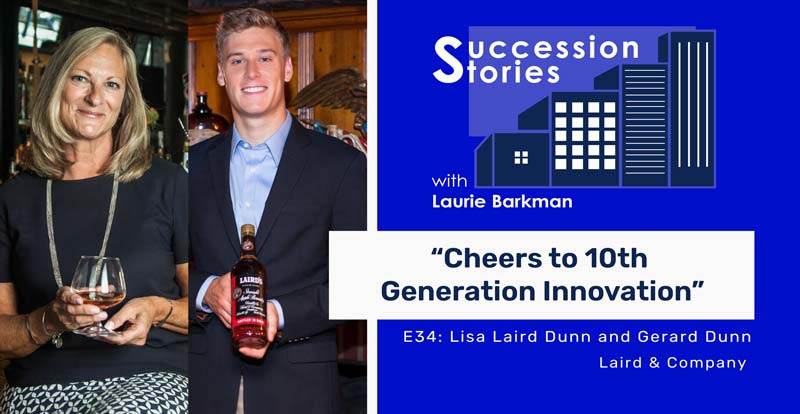
Laurie Barkman:
So you have an eye towards the future with certainly an appreciation of the past. You had mentioned in your introduction, Gerard, that you had – I think you said – swept floors, and you did all kinds of things as a teenager, and we’ll just assume the labor laws all worked out, but we won’t go there. But how did you really get interested in working in the business? Was it something that it was just assumed you would do? Or was it genuinely an interest that you had and you had developed on your own?
Gerard Dunn:
So from the start, I never really thought about it. I just worked here, as I said for some extra spending money and during the summers. But as I came back each and every summer, my responsibilities increased. Eventually I moved on from sweeping floors and cleaning out of the machines. And don’t get me wrong, I still even do that today. But I started working in our accounting department in our processing where I was actually making the batches of liquor, worked a little bit in sales and marketing as well. So as I gained more responsibility, I gained a greater sense of pride.
And the longer time I spend here – it’s hard to explain – there’s like an aura where I don’t know if it’s the history or – I think it’s the history – but it’s that greater sense of pride, as I was touching on, and it just makes me proud to work here. I never assumed I was going to join the business. I think that’s something my grandfather and my mother did exceptionally well. I never felt pressured at all. Until one day, my grandfather just walked in my office, sat down, and just straight up said out of nowhere, “So do you think you want to join the business?” And I said, “Yes.” He got up and left the office, not a word more was spoken.
Laurie Barkman:
That’s it.
Gerard Dunn:
That was it. That was the only time it was ever brought up. So I think they did a great job of not pressuring me.
Laurie Barkman:
Lisa, what’s your position on that for yourself? And then as you think about Gerard coming into the company, what were your thoughts?
Lisa Laird Dunn:
Well, obviously, I wholeheartedly wanted him to come into the company. I also have a daughter that hopefully someday will come on board. But obviously, I feel very strongly that it has to be their choice. It has to be their passion because if it isn’t their choice, or passion, or what they want to do, it’s not good for them and it’s not good for the company as well.
Luckily, my father took that avenue with me. I never felt pressured so I felt it was also important that I didn’t pressure my own children, because I saw how I started one path and then I realized that this is what I want to do. It was my decision and I think it’s very important that you don’t feel that pressure.
So yeah, and I pretty much had the same avenue that Gerard did. Worked here just to make some extra cash, worked in quality control and production, and then when I finally decided to come into the company, I went into accounting and to sales and so forth. Which is pretty funny. When I was younger and working here and working in production, we had an elderly gentleman called Jake Gunther, he’d been here for years, a local guy here in Colts Neck, and he ran our processing. He went one day into my father’s office and goes, “Do I have to listen to her?” My father goes, “Yep, if she tells you something to do, you got to listen to her.” He goes, “Okay.” And that was it.
50: Karen Norheim, Next Generation Corporate Innovation
Laurie Barkman:
Karen Norheim is the second generation President of American Crane and Equipment Corp, a specialized manufacturing company in Pennsylvania, founded by her father. This clip with Karen in episode 50 stands out to me because of our conversation about innovation in a mature company. In early 2020 at the start of the COVID pandemic, American Crane launched an Innovation Lab. I love how Karen talked about their philosophy of crawl, walk, run as a framework for launching new technologies and how they view the importance of differentiation through innovation.
Karen Norheim:
“We created the lab, we bought several different – I call them toys, they’re not really toys – yes, they are cool, but they are things that I think can truly bring us business outcomes. I put it together, put a team together and said, “Listen, here’s your funding, here’s what I want you to do. You go figure it out. Here’s your sandbox, here’s your whitespace. I’m not gonna tell you which project to go after. I’m just gonna say you’ve got my support, and you’ve got my funding. Now you smart engineers who are way smarter than me, I’m just a Sherpa for people who are far more brilliant. Go forth, figure it out and come back to me,” and my goodness, it worked so well. What they’re coming back with is just incredible and the speed. I thought some of the things that we would do would take much longer. The speed at which they’re going, the energy that’s happening is really great. I think if you have amazing people, whatever industry space you’re in, if you can create an area where they can have this sort of sandbox experience, to look at R&D, look at innovation and find things that work, and you put them together really wonderful things can happen and that’s your job as a leader to cultivate.
Laurie Barkman:
Absolutely. For organizations that are thinking, “Oh, wow, that’s quite the investment.” How do you get a return? How do you evaluate what comes out of the innovation lab in terms of what will move forward? I’m guessing out of 10 projects, maybe one will move forward? Something like that. How do you measure? How do you forecast what might be successful and put it into place?
Karen Norheim:
Well, the selection of the Augmentir software for remote collaboration came out of the Innovation Lab. We’re using a tool to look at taking 3D space models of our overhead cranes, because once they are installed they are the permanent kind. A lot of people when they think of cranes they think of mobile cranes. This is not a mobile crane. It’s similar to picking things up and putting them down, but installed in permanent facilities so that gives us a chance before it ships to know exactly where the electrical box was put on. Where’s the conduit? And what does it look like? That’s happening and the IoT and getting the smart crane technology put together is also impressive. I would say that I look to others to really determine what I was going to put there. I put some really good seeds in so the seeds that they’ve got are pretty good. But I would say what rose to the top for us was the smart crane and the IoT crane because we were fortunate enough to have an immediate situation where a customer was looking for that. So we pair both an immediate need with a long term plan. That helped to raise that to the top of the barrel. I have engineers working on this with you. They’re looking at financials; can we make this at a cost that we think we can integrate in? Is it feasible? Then at the same time, I’m looking at, “Where’s the market for this? Is this something that people need? What is it telling us out there? What are others doing?” and using that as the viability to determine that return on investment.
Laurie Barkman:
Do you talk with customers at any point in the discovery process in terms of their problems, and how your innovations might help solve those problems?
Karen Norheim:
We have started to. Now remember the Innovation Lab just started in January of 2020 so we’re just coming around our first year but yeah, we’re definitely engaging with some customers on that and talking to them specifically. We also have additive manufacturing. We do the 3D printing with onyx material and also with plastics, we’ve already put those pieces on our crane so we’re solving immediate problems for customers using that and just knowing how to use an additive machine to put something on a crane for perhaps the government or the Navy or something like that. I mean, that’s a big deal, you feel like you need to know what you’re doing so us being able to just walk in that space, walk and find ways to utilize it has been huge. Then that opens the door for the running phase. I always say with technology, you crawl, you walk, and then you run. With a lot of the stuff in the Innovation Lab right now we are walking, but we hope to select a few where we really are running at them and it’s all coming.
Laurie Barkman:
Well, your company is already – it seems to me anyway – so differentiated. I don’t know exactly how differentiated you are from your competitors, but I would guess there are ways and that these innovations are going to put that proverbial moat around the castle even more. Warren Buffett likes to look for that moat. Is that part of it too, that you see that this is going to solidify how you differentiate in the market?
Karen Norheim:
Yeah. When we talk about smart cranes and Internet of Things cranes, we have made automated cranes back in the early 90s. We have done technology that would now be considered a smart crane in the last 20 years for different applications and nuclear power plants or with NASA or high quality, moving very expensive things around. We have had those experiences so part of the innovation lab was me just pulling together these smart individuals who don’t realize that they have this nugget of amazingness and pulling them together and saying, “Hey, we can do this. We already do this, we just need to pull all the strands together and make it into sort of a cohesive unit,” and that is who we are.
In our industry, if we are the ones that people come to when nobody else can solve it, we can solve it. Those tough problems in material handling come to us and that is why the people that we do work with, the customers that we have, is what I think differentiates us. We take it as a partner, all the way to the end of your project. We’re going to work through any issues that happen. You can’t predict everything, whether it’s COVID coming in and causing some problems, whether it’s issues with supplier chains, whatever. We will work to make sure that our customer gets it and then on top of that we are the experts so we know the technical background, we are fully designed in house. All of that is done in Pennsylvania, built in the US. All of those pieces come together so I feel like that, and then coupled with craftsmanship because we really are craftsmen and there’s a lot of quality that goes into our equipment. We don’t believe in building things that are going to fall apart. We believe in building things that are right for the application and reliable and safe. I feel like those are all the things that differentiate us. I have joked before, even just on the cultural side, back to the Grit Matters piece that ‘Grit Matters’ and the great logo was me just putting the cool shirt and logo on the people who were already amazing, already hitting it out of the park, really had grit, and were all these things. It was helping them to see themselves that way and reflecting that externally, not just internally.”
69: Enterprise Value Scorecard – Steve Peplin, Talan Products
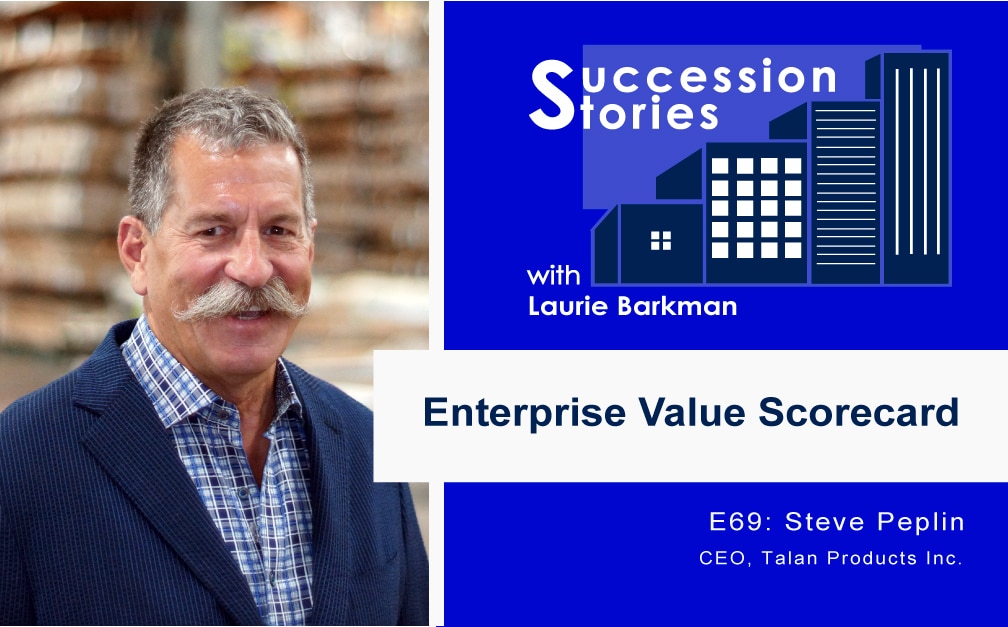
Laurie Barkman:
A common theme across many of my episodes is that all entrepreneurs will leave their company someday. Entrepreneur Steve Peplin is the Founder and CEO of Talan Products, a manufacturing company in Ohio. I chose this clip from episode 69, because I loved how Steve discussed the concept of a business scorecard and how he tracks different measurements to improve the company, especially using enterprise value as a benchmark. And I also appreciated Steve’s honest answer when I asked him about succession planning. Maybe you can relate?
Laurie Barkman:
“One of the things that I’m guessing has worked for you has been your attention to the numbers, even just as we’ve been talking in prep for this show, I could tell that you are someone who studies the market, you understand your industry very well. You understand where you compare to your peers, and you measure things as a company. It’s important, especially when you’re measuring things like safety and quality so I want to talk to you about that, what we call KPIs or key performance indicators. Another thing I saw on your website, it says ‘if it doesn’t add value for the company, don’t do it,’ so I want to ask you about this. What measures do you track for the business that you think have really been part of your success over these years?
Steve Peplin:
It’s funny, we probably have, just in the sales and marketing department, 25 things we measure every week. There are so many metrics, but with manufacturing there’s a mantra that says, ‘what gets measured gets improved.’ It’s not just manufacturing, it’s in business. I also have a saying that I said, “We have a lot of data, but discerning knowledge from the data is hard.” Tracking all this data is only the first step. You have to understand what it means and convert the data into knowledge. That’s where it gets tricky. On time delivery, quality, safety, turnover, these are the kind of metrics that are basic to manufacturing, all of which we excel at, we’re at the top. We benchmark against the industry, through our manufacturing association so we see the numbers and we’re rockstars, we really do have a high performing company.
Laurie Barkman:
What about enterprise value? Have you measured what the company is worth, gotten valuations or looked at it? I think you and I sort of met in this M&A (mergers and acquisitions) event that was online, and I had reached out to you afterwards and so I know you spend time in those circles.
Steve Peplin:
Yeah, I look at that as the ultimate scorecard so I am always aware of our market value; of the enterprise value of the company. Because that’s the ultimate scorecard. I’m not selling the company right now but we want the company to be profitable, which is one of the main metrics; people buy companies for future cash flow and that’s basically the concept. You’re buying the cash flow of the company. But it’s not just cash flow that makes a company valuable. Its culture. There’re a lot of intangibles. It’s markets served, there’s so many other intangibles that go into other components. Is the owner necessary? Does the owner have to be there? Is he intrinsic to the success of the company? Or does the company run itself and a new owner could come in and step right in? Also what’s left? What’s the next big thing that the new guy can do? There’re so many aspects of it but I think that’s the ultimate KPI – your net worth, your enterprise value.
Laurie Barkman:
For you and there’s one other owner. Is that correct?
Steve Peplin:
Yes.
Laurie Barkman:
Your business partner, and so yes, by far, it’s probably the largest asset you both have.
Steve Peplin:
Yes, it is, and here’s a good thing about growing older, when I was young, it was 90% of my net worth. As I get older, it becomes less because we’re profitable, we make money every year, and I invest that, I diversify my investments; have a diversified portfolio and so it’s funny, my financial advisor, we talked about that like, “How much of your net worth is still in Talan?”
Laurie Barkman:
That’s important for diversification.
Steve Peplin:
Yeah.
Laurie Barkman:
That’s important for diversification. A lot of business owners, this is where they start, which is the financial planning side and understanding what is it that they need for the future when they retire, what lifestyle they want to have. Do they want to travel? Do they want to buy another company or start another business? And then that sense of where is the company today? What’s it worth? And then is there a gap? All those factors that you just talked about, which are the things that help determine, what is the value? How does it compare against your peers and ultimately value is in the eye of the acquirer? It’s in the eye of the buyer.
Steve Peplin:
It’s also an element of multiples. Now the market for M&A is so frothy, it’s white hot. There’s too much money chasing too few opportunities combined with the debit demographics of the baby boomers, guys my age, I’m the peak of the baby boom bubble, I’m the rabbit going through the snake’s belly, demographically and I’m getting to an age where you’re looking at that stuff. So the multiple of EBITDA – which is a way to value companies – the multiples are climbing. The funds have so much money, they gotta use it or lose it. There’s a lot of demand, more demand and supply of companies. So when EV as a metric or KPI, I have to remove that variable because we all get credit for companies selling for higher multiples. That’s not something we did. That’s what society has provided us. So now’s a good time to sell for that reason.
Laurie Barkman:
Well, also, there’s a lot of discussion around other alternatives, such as ESOPs for companies that are large enough to try to garner the tax benefit. So it is a very interesting time, as you say, there’s a lot of dynamics and there’s a lot of activity. I want to talk about succession for a second. Do you have a succession plan in place? Whether it’s a contingency, more of an emergency, that’s different, this is more long term.
Steve Peplin:
We’re working on it. It needs work. All entrepreneurs leave their company someday.
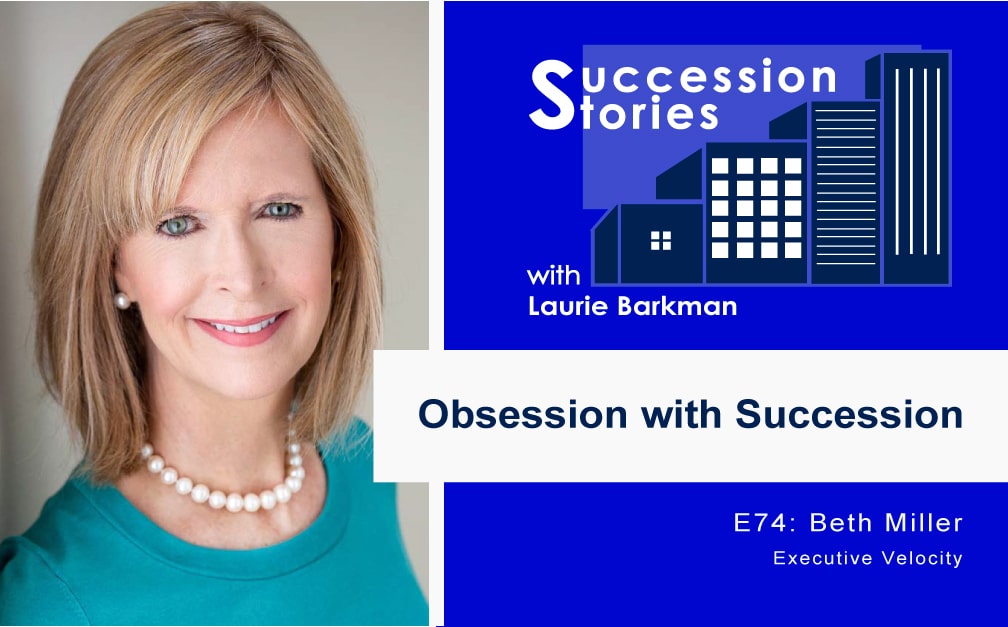
Laurie Barkman:
During the first 100 episodes of the show, Succession has often come up as a topic of conversation…of course! That’s why I chose this clip with Beth Miller from episode 74 from our conversation about succession planning. Too often business owners wait too long to develop a plan, and they don’t involve the key employees. If the plan is in your head and not communicated, what good will it do? One of the key ideas Beth shared is recognizing how succession planning can be a retention tool to help improve your business value.
Laurie Barkman:
“When it comes to exit planning and being able to create that vision as an owner, what your life might look like after the sale or after you’ve retired from your business, either way, exit in the sense of, you’re not part of the company anymore, why do you think it’s so difficult for people to think about what’s next?
Beth Miller:
The unknown, if they haven’t experienced it in the past. I think that there are some individuals that are more prone to looking into the future, while there are others that are more about the here and now, so those individuals that look more into the future and have a good support system around them, if they’re already involved, for instance, with some other activities, they could get more involved with those activities. The people that have lived so much for their company, are the ones that have a harder time letting go, at least in my experience.
The individual Dan, in the book, Dan is somebody who had some some activities, but didn’t have as much time to do them so he expanded those and then his personal situation was changing, where he was becoming a grandfather, so he wanted to spend more time so there was a personal reason for that as well. He was just very committed to making sure that not only was the exit good for him, but for his key employees as well. He had a very nice cash windfall, but his key employees also benefited from the sale as well.
Laurie Barkman:
I have the same ethos of when I work with clients, that we need to talk about the business readiness, we need to talk about the personal readiness. A lot of times the personal readiness is the afterthought, but I try to bring it forward. If they’re talking with me, they probably already have decided at some level that they want to start preparing their business for sale, or preparing it for an internal succession or some sort of exit on the other side; what’s coming in the next three years, five years, or one year can happen too.
We do have an assessment, and you probably have tools too, but we use an assessment, we call it the PRE-Score, which is personal readiness to exit. It boils it down into different attributes, like four key drivers. They dovetail very nicely with what you’re saying, and we can measure where they are in that continuum of readiness, and then talk about an action plan. What are those questions they need to be exploring?
I have a husband and wife that are clients, and the husband’s the owner of the business. But the wife works in the business and of course, she’s involved day to day and she’s leaning towards being more ready than he is for some reasons, and it’s been interesting to have that conversation too. A lot of times, I think the value that advisors can have with a client that’s contemplating, is being able to draw out these uncomfortable, uncertain kinds of things. We’re not licensed therapists, but a lot of it is fear. We’re getting older or, fear of change so this squishy place, this uncertain place. I think it is valuable to have a book like yours to be able to have the time to explore, but it’s also helpful to talk to someone.
Beth Miller:
Yes. Most of my work is asking the questions that they’ve never asked themselves. Or they’ve asked themselves, but it’s never been in the forefront of their mind. It gets them to self-reflect on what could be versus what is.
Beth Miller:
Well, I think if you’re a business owner, whether you’re 40 years old or 60 years old, it really doesn’t matter as it relates to succession planning. Succession planning is not just about you and your company, but it’s about the people internally. If you are focused on creating a path for the company as well as creating a path for the employees, hopefully, that will increase retention and right now we’ve got a huge talent war going up there, worse than we’ve ever had in the last 10-15 years, and we’ve been talking about talent war for a long time but when I talk to business owners now, the two things I talk about as the biggest challenge are talent, and supply chain. So if the employees know that there’s a succession plan, and that they’re being developed as part of that plan, you’re more likely to retain them, and retain them for a longer period of time.
Laurie Barkman:
I hope you enjoyed today’s Succession Stories Rewind featuring clips from the first 100 shows. As I encourage all of my clients, and my listeners, be purposeful. What did you hear that sparked some ideas for creating more value in your business? Maybe it was ensuring a successful succession process discussed with Beth Miller, or multi-generational succession with Laird & Company. Or industrial innovation ideas inspired by American Crane with Karen Norheim, or keeping an enterprise scorecard that Steve Peplin with Talan Products talked about.
What are 2-3 things that you’ll take action on? If you want to talk about your business, I can help you find clarity on a path forward. Set up time with me at meetlauriebarkman.com
Through these conversations, we’re creating an invaluable body of knowledge to benefit you. Support the show by becoming an Official Patron on Patreon.
Tune in next week for more insights from transition to transaction. Until then…here’s to your success!

